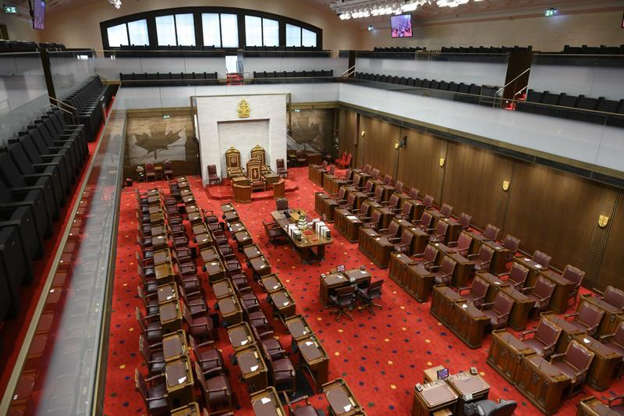Alberta
Retired Oil Field Worker sparks national conversation with his pitch for a new route to move Alberta Oil

The following Opinion piece comes from local writer / editorialist (and former oil field worker) Garfield Marks.
We have not been able to run our bitumen through a pipeline to a refinery in New Brunswick. There has been resistance in parts of Ontario and in Quebec. What if we came up with another plan. Would we consider it? There will be road blocks, but not insurmountable, would we consider it?
Yes how about Thunder Bay?
Thunder Bay, Ontario, the largest Canadian port of the St. Lawrence Seaway located on the west end of Lake Superior, 1850 kms. from Hardisty, Alberta. A forgotten jewel.
So what, you may ask.
They used to ship grain from Thunder Bay in huge tankers to ports all over the world. Why not oil?
The Saint Lawrence Seaway ships fuel, gasoline and diesel tankers, to this day.
We could run oil tankers to the Irving refinery in New Brunswick, bypassing the controversial pipeline running through eastern Ontario and Quebec.
The pipeline, if that was the transport model chosen, would only need to run through parts of Alberta, Saskatchewan, Manitoba and Ontario. Like, previously stated the pipeline would only be 1850 kms. long.
The other great thing about Thunder Bay is the abundance of rail lines. Transportation for such things as grain and forestry products from western Canada. If you can’t run pipeline from Hardisty, through to Thunder Bay, use the railroad.
Why Hardisty, you may ask.
Hardisty, according to Wikipedia, is mainly known as a pivotal petroleum industry hub where petroleum products such as Western Canada Select blended crude oil and Hardisty heavy oil are produced, stored and traded.
The Town of Hardisty owes its very existence to the Canadian Pacific Railway. About 1904 the surveyors began to survey the railroad from the east and decided to locate a divisional point at Hardisty because of the good water supply from the river.
Hardisty, Alberta has the railroad and has the product, the storage capacity, and the former Alberta government planned on investing $3.7 billion in rail cars for hauling oil while Thunder Bay has the railroad and an under utilised port at the head of the St. Lawrence Seaway.
Economics are there along with opportunity, employment would be created and the east coast could end its’ dependency on imported oil.
Do we have the vision or willingness to consider another option. I am just asking for all avenues to be considered.
In my interviews in Ontario there is a willingness to discuss this idea.
The St. Lawrence Seaway Management Corporation is still reviewing the idea of shipping crude oil from western Canada through its system, and it’s a long way from happening, according to Bruce Hodgson, the Seaway’s director of market development.
“Obviously, there needs to be an ongoing commitment on the part of a producer, and so that’s going to be required for any project of this nature,” he said.
We could consider it, could we not?
CBC NEWS did a story about this idea on March 7 2019;
A retired oil field worker in Alberta has “floated” a novel solution to Alberta’s oil transportation woes: pipe the bitumen to Thunder Bay, Ont., then ship it up the St. Lawrence Seaway to the Irving oil refinery in New Brunswick.
Marks’ proposal might be more than a pipe dream, according to the director of the Queen’s Institute for Energy and Environmental Policy.
‘I don’t think that it’s a totally nuts idea’
“I don’t think that it’s a totally nuts idea,” Warren Mabee said. “I think that there’s some flaws to it … but this is an idea that could work in certain circumstances and at certain times of year. … It’s not the craziest thing I’ve ever heard.”
The chief executive officer of the Port of Thunder Bay said shipping oil from the port “could easily be done.”
“We ship refined gasoline and diesel up from Sarnia. We’ve done that for many many years,” Tim Heney told CBC. “So it’s not something that’s that far-fetched.”
There are, however, plenty of potential drawbacks to shipping crude through the Seaway, Mabee explained, not least of which is the fact that it isn’t open year-round.
The need to store oil or redirect it during the winter months could be costly, he said.
Potential roadblocks
Another potential pitfall is capacity, he added; there may not be enough of the right-sized tankers available to carry the oil through the Seaway.
Finally, he said, the journey by sea from Lake Superior to the Irving refinery in New Brunswick is a long one, so it might make more sense to transport the product to a closer facility such as the one in Sarnia, Ont.
The St. Lawrence Seaway Management Corporation is still reviewing the idea of shipping crude oil from western Canada through its system, and it’s a long way from happening, according to Bruce Hodgson, the Seaway’s director of market development.
“Obviously, there needs to be an ongoing commitment on the part of a producer, and so that’s going to be required for any project of this nature,” he said.
So far, no producer has come forward seeking to ship crude through Thunder Bay, he said.
Asked about the possible environmental risks of shipping oil on Lake Superior, both Hodgson and Heney said shipping by tanker is relatively safe; Hodgson noted that any tankers carrying the product would have to be double-hulled, and crews are heavily vetted.
Time to rethink pipelines?
There hasn’t been a spill in the Seaway system for more than 20 years he said.
Nonetheless, Mabee said, the potential for an oil spill on the Great Lakes could be a huge issue.
“The St. Lawrence and the Great Lakes have a lot of people living in close proximity, a lot of people who rely on it for drinking water,” he said. “There’s a delicate ecosystem there. I think a lot of people would push back against this proposal simply from that perspective.”
In fact, one of the reasons Mabee appreciates Marks’ proposal, he said, is because it invites people to weigh the pros and cons of different methods of transporting oil.
“If we’re not going to build pipelines, but we’re going to continue to use oil, it means that people are going to be looking at some of these alternative transport options,” he said.
“And if we don’t want oil on those alternative transport options, we need to give the pipelines another thought.
Time to consider all options, I dare say.
Garfield Marks
Alberta
CPP another example of Albertans’ outsized contribution to Canada

From the Fraser Institute
By Tegan Hill
Amid the economic uncertainty fuelled by Trump’s trade war, its perhaps more important than ever to understand Alberta’s crucial role in the federation and its outsized contribution to programs such as the Canada Pension Plan (CPP).
From 1981 to 2022, Albertan’s net contribution to the CPP—meaning the amount Albertans paid into the program over and above what retirees in Alberta received in CPP payments—was $53.6 billion. In 2022 (the latest year of available data), Albertans’ net contribution to the CPP was $3.0 billion.
During that same period (1981 to 2022), British Columbia was the only other province where residents paid more into the CPP than retirees received in benefits—and Alberta’s contribution was six times greater than B.C.’s contribution. Put differently, residents in seven out of the nine provinces that participate in the CPP (Quebec has its own plan) receive more back in benefits than they contribute to the program.
Albertans pay an outsized contribution to federal and national programs, including the CPP because of the province’s relatively high rates of employment, higher average incomes and younger population (i.e. more workers pay into the CPP and less retirees take from it).
Put simply, Albertan workers have been helping fund the retirement of Canadians from coast to coast for decades, and without Alberta, the CPP would look much different.
How different?
If Alberta withdrew from the CPP and established its own standalone provincial pension plan, Alberta workers would receive the same retirement benefits but at a lower cost (i.e. lower CPP contribution rate deducted from our paycheques) than other Canadians, while the contribution rate—essentially the CPP tax rate—to fund the program would likely need to increase for the rest of the country to maintain the same benefits.
And given current demographic projections, immigration patterns and Alberta’s long history of leading the provinces in economic growth, Albertan workers will likely continue to pay more into the CPP than Albertan retirees get back from it.
Therefore, considering Alberta’s crucial role in national programs, the next federal government—whoever that may be—should undo and prevent policies that negatively impact the province and Albertans ability to contribute to Canada. Think of Bill C-69 (which imposes complex, uncertain and onerous review requirements on major energy projects), Bill C-48 (which bans large oil tankers off B.C.’s northern coast and limits access to Asian markets), an arbitrary cap on oil and gas emissions, numerous other “net-zero” targets, and so on.
Canada faces serious economic challenges, including a trade war with the United States. In times like this, it’s important to remember Alberta’s crucial role in the federation and the outsized contributions of Alberta workers to the wellbeing of Canadians across the country.
Alberta
Made in Alberta! Province makes it easier to support local products with Buy Local program

Show your Alberta side. Buy Local. |
When the going gets tough, Albertans stick together. That’s why Alberta’s government is launching a new campaign to benefit hard-working Albertans.
Global uncertainty is threatening the livelihoods of hard-working Alberta farmers, ranchers, processors and their families. The ‘Buy Local’ campaign, recently launched by Alberta’s government, encourages consumers to eat, drink and buy local to show our unified support for the province’s agriculture and food industry.
The government’s ‘Buy Local’ campaign encourages consumers to buy products from Alberta’s hard-working farmers, ranchers and food processors that produce safe, nutritious food for Albertans, Canadians and the world.
“It’s time to let these hard-working Albertans know we have their back. Now, more than ever, we need to shop local and buy made-in-Alberta products. The next time you are grocery shopping or go out for dinner or a drink with your friends or family, support local to demonstrate your Alberta pride. We are pleased tariffs don’t impact the ag industry right now and will keep advocating for our ag industry.”
Alberta’s government supports consumer choice. We are providing tools to help folks easily identify Alberta- and Canadian-made foods and products. Choosing local products keeps Albertans’ hard-earned dollars in our province. Whether it is farm-fresh vegetables, potatoes, honey, craft beer, frozen food or our world-renowned beef, Alberta has an abundance of fresh foods produced right on our doorstep.
Quick facts
- This summer, Albertans can support local at more than 150 farmers’ markets across the province and meet the folks who make, bake and grow our food.
- In March 2023, the Alberta government launched the ‘Made in Alberta’ voluntary food and beverage labelling program to support local agriculture and food sectors.
- Through direct connections with processors, the program has created the momentum to continue expanding consumer awareness about the ‘Made in Alberta’ label to help shoppers quickly identify foods and beverages produced in our province.
- Made in Alberta product catalogue website
Related information
-

 International2 days ago
International2 days agoPope Francis has died aged 88
-

 International2 days ago
International2 days agoPope Francis Dies on Day after Easter
-

 International2 days ago
International2 days agoJD Vance was one of the last people to meet Pope Francis
-

 2025 Federal Election1 day ago
2025 Federal Election1 day agoOttawa Confirms China interfering with 2025 federal election: Beijing Seeks to Block Joe Tay’s Election
-

 Business2 days ago
Business2 days agoCanada Urgently Needs A Watchdog For Government Waste
-

 Energy2 days ago
Energy2 days agoIndigenous-led Projects Hold Key To Canada’s Energy Future
-

 2025 Federal Election20 hours ago
2025 Federal Election20 hours agoBREAKING: THE FEDERAL BRIEF THAT SHOULD SINK CARNEY
-

 COVID-191 day ago
COVID-191 day agoNearly Half of “COVID-19 Deaths” Were Not Due to COVID-19 – Scientific Reports Journal






